「Dev:Py/Scripts/Cookbook/Code snippets/Other data types」の版間の差分
細 (moved Dev:2.5/Py/Scripts/Cookbook/Code snippets/Other data types to Dev:Py/Scripts/Cookbook/Code snippets/Other data types: remove version namespace) |
(相違点なし)
|
2015年12月28日 (月) 04:24時点における版
Other data types
Text
This program adds a piece of text to the viewport and sets some attributes. Note that the data type is TextCurve; the type Text is for text in the text editor.
#----------------------------------------------------------
# File text.py
#----------------------------------------------------------
import bpy
import math
from math import pi
def run(origin):
# Create and name TextCurve object
bpy.ops.object.text_add(
location=origin,
rotation=(pi/2,0,0))
ob = bpy.context.object
ob.name = 'HelloWorldText'
tcu = ob.data
tcu.name = 'HelloWorldData'
# TextCurve attributes
tcu.body = "Hello, world"
tcu.font = bpy.data.fonts[0]
tcu.offset_x = -9
tcu.offset_y = -0.25
tcu.shear = 0.5
tcu.size = 3
tcu.space_character = 2
tcu.space_word = 4
# Inherited Curve attributes
tcu.extrude = 0.2
tcu.fill_mode="FRONT"
tcu.use_fill_deform = True
tcu.fill_mode="FRONT"
if __name__ == "__main__":
run((0,0,0))
Layers
This program illustrates three methods to place an object on a new level:
- Create it on the right level.
- Create it on the layer 1, and change
Object.layer. - Create it on the layer 1, and use an operator to move it.
It is also shown how to change the visible layers.
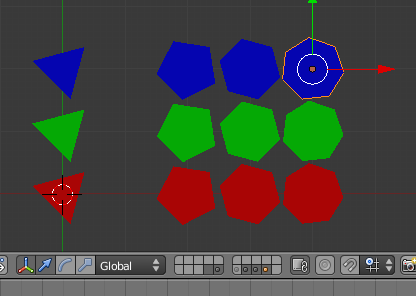
#----------------------------------------------------------
# File layers.py
#----------------------------------------------------------
import bpy
def createOnLayer(mat):
for n in range(3, 8):
# Create a n-gon on layer n+11
layers = 20*[False]
layers[n+11] = True
bpy.ops.mesh.primitive_circle_add(
vertices=n,
radius=0.5,
fill=True,
view_align=True,
layers=layers,
location=(n-3,0,0)
)
bpy.context.object.data.materials.append(mat)
return
def changeLayerData(mat):
for n in range(3, 8):
# Create a n-gon on layer 1
bpy.ops.mesh.primitive_circle_add(
vertices=n,
radius=0.5,
fill=True,
view_align=True,
location=(n-3,1,0)
)
bpy.context.object.data.materials.append(mat)
# Then move it to a new layer
ob = bpy.context.object
ob.layers[n+11] = True
# Remove it from other layers.
layers = 20*[False]
layers[n+11] = True
for m in range(20):
ob.layers[m] = layers[m]
return
def moveLayerOperator(mat):
for n in range(3, 8):
# Create a n-gon on layer 1
bpy.ops.mesh.primitive_circle_add(
vertices=n,
radius=0.5,
fill=True,
view_align=True,
location=(n-3,2,0)
)
bpy.context.object.data.materials.append(mat)
# Then move it to a new layer
layers = 20*[False]
layers[n+11] = True
bpy.ops.object.move_to_layer(layers=layers)
return
def run():
# Create some materials
red = bpy.data.materials.new('Red')
red.diffuse_color = (1,0,0)
green = bpy.data.materials.new('Green')
green.diffuse_color = (0,1,0)
blue = bpy.data.materials.new('Blue')
blue.diffuse_color = (0,0,1)
# Three methods to move objects to new layer
createOnLayer(red)
changeLayerData(green)
moveLayerOperator(blue)
# Select layers 14 - 20
scn = bpy.context.scene
bpy.ops.object.select_all(action='SELECT')
for n in range(13,19):
scn.layers[n] = True
# Deselect layers 1 - 13, but only afterwards.
# Seems like at least one layer must be selected at all times.
for n in range(0,13):
scn.layers[n] = False
# Deselect layer 16
scn.layers[15] = False
return
if __name__ == "__main__":
run()
Groups
This program shows how to create groups, add objects to groups, and empties that duplicates the groups. We add four groups, four mesh objects assigned to two groups each, and four texts assigned to a single group. Then we add four empties, which dupli-group the four groups. Finally the empties are moved so each row contains the elements in that group.
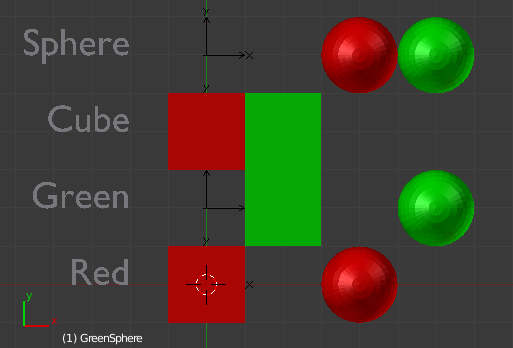
#----------------------------------------------------------
# File groups.py
# Create groups
#----------------------------------------------------------
import bpy
import mathutils
from mathutils import Vector
# Layers
Display = 5
Build = 6
def setObject(name, mat):
ob = bpy.context.object
ob.name = name
ob.data.materials.append(mat)
return ob
# Move object to given layer.
def moveToLayer(ob, layer):
ob.layers[layer] = True
for n in range(20):
if n != layer:
ob.layers[n] = False
return
# Add a TextCurve object in layer 13
def addText(string, loc):
tcu = bpy.data.curves.new(string+'Data', 'FONT')
text = bpy.data.objects.new(string+'Text', tcu)
tcu.body = string
tcu.align = 'RIGHT'
text.location = loc
bpy.context.scene.objects.link(text)
# Must change text.layers after text has been linked to scene,
# otherwise the change may not stick.
moveToLayer(text, Build)
return text
def run():
# Create two materials
red = bpy.data.materials.new('RedMat')
red.diffuse_color = (1,0,0)
green = bpy.data.materials.new('GreenMat')
green.diffuse_color = (0,1,0)
# Locations
origin = Vector((0,0,0))
dx = Vector((2,0,0))
dy = Vector((0,2,0))
dz = Vector((0,0,2))
# Put objects on the build layer
layers = 20*[False]
layers[Build] = True
# Create objects
bpy.ops.mesh.primitive_cube_add(location=dz, layers=layers)
redCube = setObject('RedCube', red)
bpy.ops.mesh.primitive_cube_add(location=dx+dz, layers=layers)
greenCube = setObject('GreenCube', green)
bpy.ops.mesh.primitive_uv_sphere_add(location=2*dx+dz, layers=layers)
redSphere = setObject('RedSphere', red)
bpy.ops.mesh.primitive_uv_sphere_add(location=3*dx+dz, layers=layers)
greenSphere = setObject('GreenSphere', green)
# Create texts
redText = addText('Red', -dx)
greenText = addText('Green', -dx)
cubeText = addText('Cube', -dx)
sphereText = addText('Sphere', -dx)
# Create groups
redGrp = bpy.data.groups.new('RedGroup')
greenGrp = bpy.data.groups.new('GreenGroup')
cubeGrp = bpy.data.groups.new('CubeGroup')
sphereGrp = bpy.data.groups.new('SphereGroup')
# Table of group members
members = {
redGrp : [redCube, redSphere, redText],
greenGrp : [greenCube, greenSphere, greenText],
cubeGrp : [redCube, greenCube, cubeText],
sphereGrp : [redSphere, greenSphere, sphereText]
}
# Link objects to groups
for group in members.keys():
for ob in members[group]:
group.objects.link(ob)
# List of empties
empties = [
('RedEmpty', origin, redGrp),
('GreenEmpty', dy, greenGrp),
('CubeEmpty', 2*dy, cubeGrp),
('SphereEmpty', 3*dy, sphereGrp)
]
# Create Empties and put them on the display layer
scn = bpy.context.scene
for (name, loc, group) in empties:
empty = bpy.data.objects.new(name, None)
empty.location = loc
empty.name = name
empty.dupli_type = 'GROUP'
empty.dupli_group = group
scn.objects.link(empty)
moveToLayer(empty, Display)
# Make display layer into the active layer
scn.layers[Display] = True
for n in range(20):
if n != Display:
scn.layers[n] = False
return
if __name__ == "__main__":
run()
Lattice
This program adds an icosphere deformed by a lattice. The lattice modifier only acts on the vertex group on the upper half of the sphere.
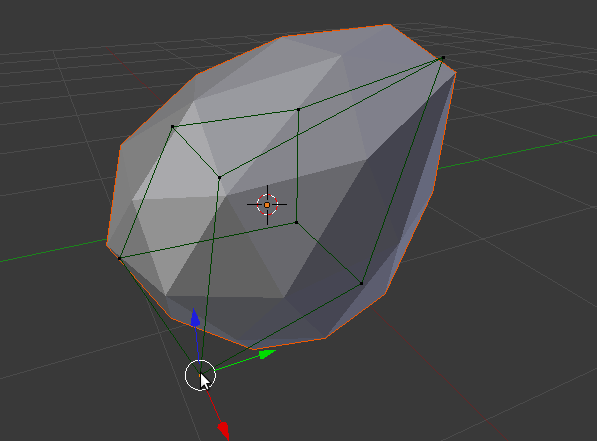
#----------------------------------------------------------
# File lattice.py
#----------------------------------------------------------
import bpy
def createIcoSphere(origin):
# Create an icosphere
bpy.ops.mesh.primitive_ico_sphere_add(location=origin)
ob = bpy.context.object
me = ob.data
# Create vertex groups
upper = ob.vertex_groups.new('Upper')
lower = ob.vertex_groups.new('Lower')
for v in me.vertices:
if v.co[2] > 0.001:
upper.add([v.index], 1.0, 'REPLACE')
elif v.co[2] < -0.001:
lower.add([v.index], 1.0, 'REPLACE')
else:
upper.add([v.index], 0.5, 'REPLACE')
lower.add([v.index], 0.5, 'REPLACE')
return ob
def createLattice(origin):
# Create lattice and object
lat = bpy.data.lattices.new('MyLattice')
ob = bpy.data.objects.new('LatticeObject', lat)
ob.location = origin
ob.show_x_ray = True
# Link object to scene
scn = bpy.context.scene
scn.objects.link(ob)
scn.objects.active = ob
scn.update()
# Set lattice attributes
lat.interpolation_type_u = 'KEY_LINEAR'
lat.interpolation_type_v = 'KEY_CARDINAL'
lat.interpolation_type_w = 'KEY_BSPLINE'
lat.use_outside = False
lat.points_u = 2
lat.points_v = 2
lat.points_w = 2
# Set lattice points
s = 1.0
points = [
(-s,-s,-s), (s,-s,-s), (-s,s,-s), (s,s,-s),
(-s,-s,s), (s,-s,s), (-s,s,s), (s,s,s)
]
for n,pt in enumerate(lat.points):
for k in range(3):
#pt.co[k] = points[n][k]
pass
return ob
def run(origin):
sphere = createIcoSphere(origin)
lat = createLattice(origin)
# Create lattice modifier
mod = sphere.modifiers.new('Lat', 'LATTICE')
mod.object = lat
mod.vertex_group = 'Upper'
# Lattice in edit mode for easy deform
bpy.context.scene.update()
bpy.ops.object.mode_set(mode='EDIT')
return
if __name__ == "__main__":
run((0,0,0))
Curve
This program adds a Bezier curve. It also adds a Nurbs circle which is used as a bevel object.
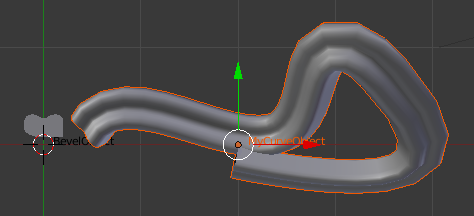
#----------------------------------------------------------
# File curve.py
#----------------------------------------------------------
import bpy
def createBevelObject():
# Create Bevel curve and object
cu = bpy.data.curves.new('BevelCurve', 'CURVE')
ob = bpy.data.objects.new('BevelObject', cu)
bpy.context.scene.objects.link(ob)
# Set some attributes
cu.dimensions = '2D'
cu.resolution_u = 6
cu.twist_mode = 'MINIMUM'
ob.show_name = True
# Control point coordinates
coords = [
(0.00,0.08,0.00,1.00),
(-0.20,0.08,0.00,0.35),
(-0.20,0.19,0.00,1.00),
(-0.20,0.39,0.00,0.35),
(0.00,0.26,0.00,1.00),
(0.20,0.39,0.00,0.35),
(0.20,0.19,0.00,1.00),
(0.20,0.08,0.00,0.35)
]
# Create spline and set control points
spline = cu.splines.new('NURBS')
nPointsU = len(coords)
spline.points.add(nPointsU)
for n in range(nPointsU):
spline.points[n].co = coords[n]
# Set spline attributes. Points probably need to exist here.
spline.use_cyclic_u = True
spline.resolution_u = 6
spline.order_u = 3
return ob
def createCurveObject(bevob):
# Create curve and object
cu = bpy.data.curves.new('MyCurve', 'CURVE')
ob = bpy.data.objects.new('MyCurveObject', cu)
bpy.context.scene.objects.link(ob)
# Set some attributes
cu.bevel_object = bevob
cu.dimensions = '3D'
cu.use_fill_back = True
cu.use_fill_front = True
ob.show_name = True
# Bezier coordinates
beziers = [
((-1.44,0.20,0.00), (-1.86,-0.51,-0.36), (-1.10,0.75,0.28)),
((0.42,0.13,-0.03), (-0.21,-0.04,-0.27), (1.05,0.29,0.21)),
((1.20,0.75,0.78), (0.52,1.36,1.19), (2.76,-0.63,-0.14))
]
# Create spline and set Bezier control points
spline = cu.splines.new('BEZIER')
nPointsU = len(beziers)
spline.bezier_points.add(nPointsU)
for n in range(nPointsU):
bpt = spline.bezier_points[n]
(bpt.co, bpt.handle_left, bpt.handle_right) = beziers[n]
return ob
def run(origin):
bevob = createBevelObject()
bevob.location = origin
curveob = createCurveObject(bevob)
curveob.location = origin
bevob.select = False
curveob.select = True
bpy.ops.transform.translate(value=(2,0,0))
return
if __name__ == "__main__":
run((0,0,0))
Curve types
This program illustrates the difference between the curve types: POLY, NURBS and BEZIER.
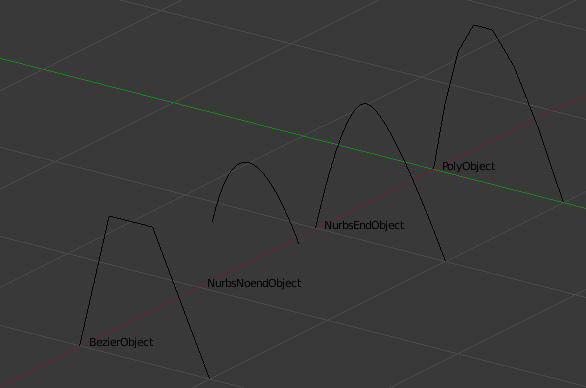
#----------------------------------------------------------
# File curve_types.py
#----------------------------------------------------------
import bpy
from math import sin, pi
# Poly and nurbs
def makePolySpline(cu):
spline = cu.splines.new('POLY')
cu.dimensions = '3D'
addPoints(spline, 8)
def makeNurbsSpline(cu):
spline = cu.splines.new('NURBS')
cu.dimensions = '3D'
addPoints(spline, 4)
spline.order_u = 3
return spline
def addPoints(spline, nPoints):
spline.points.add(nPoints-1)
delta = 1/(nPoints-1)
for n in range(nPoints):
spline.points[n].co = (0, n*delta, sin(n*pi*delta), 1)
# Bezier
def makeBezierSpline(cu):
spline = cu.splines.new('BEZIER')
cu.dimensions = '3D'
order = 3
addBezierPoints(spline, order+1)
spline.order_u = order
def addBezierPoints(spline, nPoints):
spline.bezier_points.add(nPoints-1)
bzs = spline.bezier_points
delta = 1/(nPoints-1)
for n in range(nPoints):
bzs[n].co = (0, n*delta, sin(n*pi*delta))
print(bzs[n].co)
for n in range(1, nPoints):
bzs[n].handle_left = bzs[n-1].co
for n in range(nPoints-1):
bzs[n].handle_right = bzs[n+1].co
return spline
# Create curve and object and link to scene
def makeCurve(name, origin, dx):
cu = bpy.data.curves.new('%sCurve' % name, 'CURVE')
ob = bpy.data.objects.new('%sObject' % name, cu)
(x,y,z) = origin
ob.location = (x+dx,y,z)
ob.show_name = True
bpy.context.scene.objects.link(ob)
return cu
def run(origin):
polyCurve = makeCurve("Poly", origin, 0)
makePolySpline(polyCurve)
nurbsCurve = makeCurve("NurbsEnd", origin, 1)
spline = makeNurbsSpline(nurbsCurve)
spline.use_endpoint_u = True
nurbsCurve = makeCurve("NurbsNoend", origin, 2)
spline = makeNurbsSpline(nurbsCurve)
spline.use_endpoint_u = False
bezierCurve = makeCurve("Bezier", origin, 3)
makeBezierSpline(bezierCurve)
return
if __name__ == "__main__":
run((0,0,0))
Path
This program adds a path and a monkey with a follow path constraint.
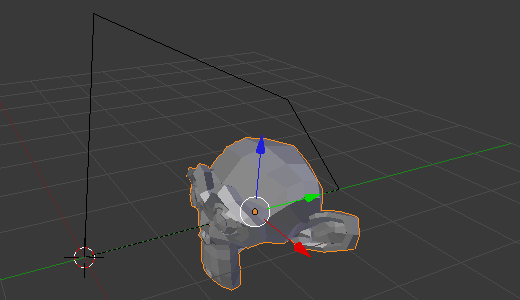
#----------------------------------------------------------
# File path.py
#----------------------------------------------------------
import bpy
def run(origin):
# Create path data and object
path = bpy.data.curves.new('MyPath', 'CURVE')
pathOb = bpy.data.objects.new('Path', path)
pathOb.location = origin
bpy.context.scene.objects.link(pathOb)
# Set path data
path.dimensions = '3D'
path.use_path = True
path.use_path_follow = True
path.path_duration = 100
# Animate path
path.eval_time = 0
path.keyframe_insert(data_path="eval_time", frame=0)
path.eval_time = 100
path.keyframe_insert(data_path="eval_time", frame=250)
# Add a spline to path
spline = path.splines.new('POLY')
spline.use_cyclic_u = True
spline.use_endpoint_u = False
# Add points to spline
pointTable = [(0,0,0,0), (1,0,3,0),
(1,2,2,0), (0,4,0,0), (0,0,0,0)]
nPoints = len(pointTable)
spline.points.add(nPoints-1)
for n in range(nPoints):
spline.points[n].co = pointTable[n]
# Add a monkey
bpy.ops.mesh.primitive_monkey_add()
monkey = bpy.context.object
# Add follow path constraint to monkey
cns = monkey.constraints.new('FOLLOW_PATH')
cns.target = pathOb
cns.use_curve_follow = True
cns.use_curve_radius = True
cns.use_fixed_location = False
cns.forward_axis = 'FORWARD_Z'
cns.up_axis = 'UP_Y'
return
if __name__ == "__main__":
run((0,0,0))
bpy.ops.screen.animation_play(reverse=False, sync=False)
Camera and lights
This program adds a sun light to the scene, and a spot light for every render object in the scene. Each spot has a TrackTo constraint making to point to its object, whereas the sun tracks the center of all objects in the scene.
#----------------------------------------------------------
# File camera.py
# Adds one camera and several lights
#----------------------------------------------------------
import bpy, mathutils, math
from mathutils import Vector
from math import pi
def findMidPoint():
sum = Vector((0,0,0))
n = 0
for ob in bpy.data.objects:
if ob.type not in ['CAMERA', 'LAMP', 'EMPTY']:
sum += ob.location
n += 1
if n == 0:
return sum
else:
return sum/n
def addTrackToConstraint(ob, name, target):
cns = ob.constraints.new('TRACK_TO')
cns.name = name
cns.target = target
cns.track_axis = 'TRACK_NEGATIVE_Z'
cns.up_axis = 'UP_Y'
cns.owner_space = 'WORLD'
cns.target_space = 'WORLD'
return
def createLamp(name, lamptype, loc):
bpy.ops.object.add(
type='LAMP',
location=loc)
ob = bpy.context.object
ob.name = name
lamp = ob.data
lamp.name = 'Lamp'+name
lamp.type = lamptype
return ob
def createLamps(origin, target):
deg2rad = 2*pi/360
sun = createLamp('sun', 'SUN', origin+Vector((0,20,50)))
lamp = sun.data
lamp.type = 'SUN'
addTrackToConstraint(sun, 'TrackMiddle', target)
for ob in bpy.context.scene.objects:
if ob.type == 'MESH':
spot = createLamp(ob.name+'Spot', 'SPOT', ob.location+Vector((0,2,1)))
bpy.ops.transform.resize(value=(0.5,0.5,0.5))
lamp = spot.data
# Lamp
lamp.type = 'SPOT'
lamp.color = (0.5,0.5,0)
lamp.energy = 0.9
lamp.falloff_type = 'INVERSE_LINEAR'
lamp.distance = 7.5
# Spot shape
lamp.spot_size = 30*deg2rad
lamp.spot_blend = 0.3
# Shadows
lamp.shadow_method = 'BUFFER_SHADOW'
lamp.use_shadow_layer = True
lamp.shadow_buffer_type = 'REGULAR'
lamp.shadow_color = (0,0,1)
addTrackToConstraint(spot, 'Track'+ob.name, ob)
return
def createCamera(origin, target):
# Create object and camera
bpy.ops.object.add(
type='CAMERA',
location=origin,
rotation=(pi/2,0,pi))
ob = bpy.context.object
ob.name = 'MyCamOb'
cam = ob.data
cam.name = 'MyCam'
addTrackToConstraint(ob, 'TrackMiddle', target)
# Lens
cam.type = 'PERSP'
cam.lens = 75
cam.lens_unit = 'MILLIMETERS'
cam.shift_x = -0.05
cam.shift_y = 0.1
cam.clip_start = 10.0
cam.clip_end = 250.0
empty = bpy.data.objects.new('DofEmpty', None)
empty.location = origin+Vector((0,10,0))
cam.dof_object = empty
# Display
cam.show_title_safe = True
cam.show_name = True
# Make this the current camera
scn = bpy.context.scene
scn.camera = ob
return ob
def run(origin):
# Delete all old cameras and lamps
scn = bpy.context.scene
for ob in scn.objects:
if ob.type == 'CAMERA' or ob.type == 'LAMP':
scn.objects.unlink(ob)
# Add an empty at the middle of all render objects
midpoint = findMidPoint()
bpy.ops.object.add(
type='EMPTY',
location=midpoint),
target = bpy.context.object
target.name = 'Target'
createCamera(origin+Vector((50,90,50)), target)
createLamps(origin, target)
return
if __name__ == "__main__":
run(Vector((0,0,0)))
